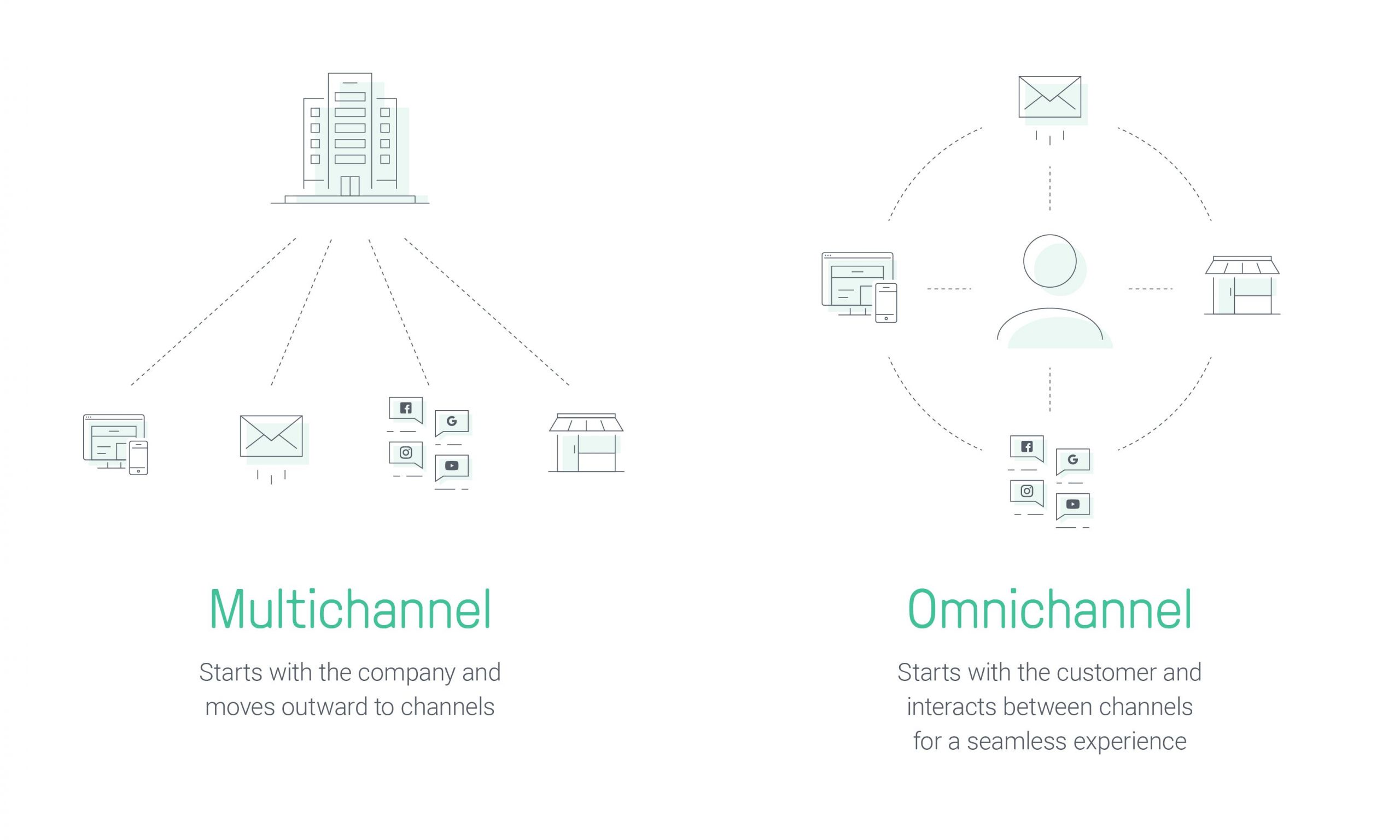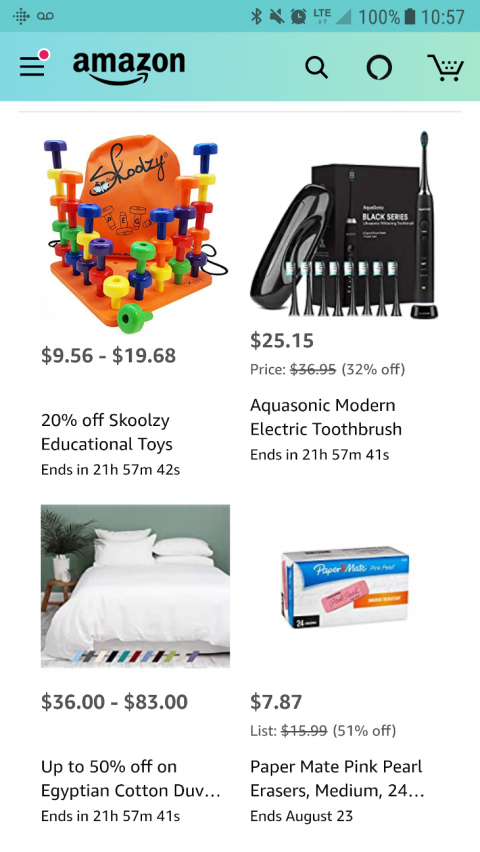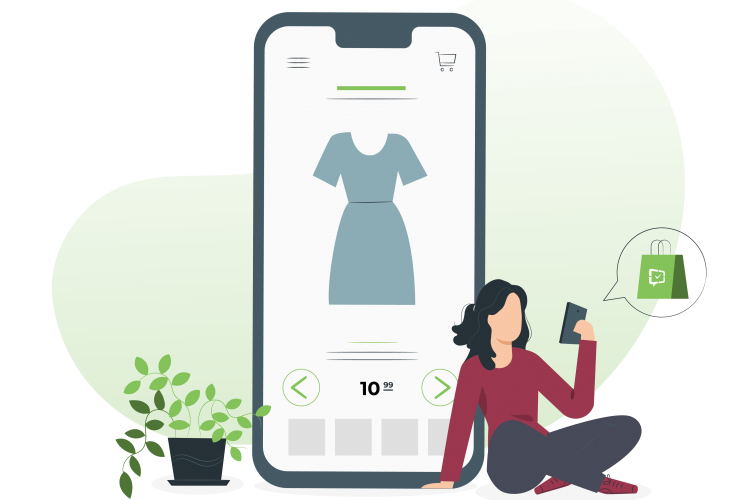Table of contents
1. Be customer-centric
2. Get the basics down
3. Optimise for mobile
4. Take advantage of persuasion triggers
5. Conclusion
1. Be customer-centric
Go beyond understanding your audience’s needs and preferences and place them at the centre of your operations. Recent findings suggest that customer-centric businesses are more profitable by up to 60% than companies that aren’t. Here are some critical changes you can consider to adapt to this trend:
1.1 Adopt an omnichannel strategy
An omnichannel e-commerce marketing strategy involves providing seamless customer experiences across multiple channels. So, if a customer shops on your mobile app but prefers to check out on your website, the experience should be consistent.

Multichannel vs. Omnichannel Marketing (source: Omnisend)
Adopting this strategy empowers your audience and allows them to personalise their own experiences with your brand. Consequently, they’re more likely to advocate your business, recommend you to their networks, and become loyal customers.
1.2 Make customer support easily accessible
Competition is now incredibly fierce among similar e-commerce businesses. Often, the best competitive advantage that could win an entire market over is effective and easily accessible omnichannel customer support.
Make support channels prominent in your platforms. Let your users feel that competent assistance is available to them whenever they need it and however they prefer to access it. If possible, offer a live chat function along with more traditional channels like phone calls and email.
1.3 Offer a hyper-personalised customer experience
Use the data you gather along with powerful marketing software to customise all your customer interactions. Doing so will enable you to provide extremely personalised experiences to each of your customers.
Hyper-personalisation is something you should strive for at every point of the customer journey. It should allow you to have more targeted offerings not just in terms of content but also in your products and services. Consequently, you enjoy higher conversions and better sales overall.
1.4 Be welcoming to guests
Many e-commerce platforms mistakenly try to get more users by forcing registration. Although that tactic might work for some types of businesses, it does the opposite of what it’s intended to do for e-commerce.
If you run a digital business, don’t repel visitors by asking for too much, too soon. Instead, make guests feel welcome and use UX design basics to coax rather than compel them to sign up.
2. Get the basics down
Your website or app should have all the UX basics covered. That should start with good design since poor aesthetics might cause you to lose up to 52% of your audience. Apart from proper graphics and layout, here are some user experience fundamentals you should have already tackled by now:
2.1 Always use high-quality media
At this point, it should already go without saying that you should invest in the photos, videos, and other visual assets you use on your e-commerce platform. Avoid low-quality media at all costs because it drastically affects the aesthetics of your site and cheapens your brand.
Additionally, it’s essential that you provide photos of your products from several angles. Your goal is to address any doubts potential buyers might have about your product by giving them the confidence that they know exactly what they will be getting.
2.2 Take advantage of product descriptions
So many e-commerce sites use product descriptions incorrectly. Although this is undeniably a good place for convincing copy, you should also make sure to use this space for its actual purpose: to describe.

Because customers won’t have the luxury of examining products in person, they’ll rely on your words to imagine what they’ll be getting. Along with photos, a good and thorough description can eliminate any hesitations a buyer might have and drive them to push through with the purchase.
2.3 Make your competitive advantages known
If you’re making an effort to give your customers what they want before they even realise they want it, make it known. Don’t wait for them to realise it on their own. Instead, publish it prominently on your platform.
Think of all the significant advantages your customers have to gain by buying from you rather than your competitor. Whether you offer same-day dispatch or free samples for every purchase, make sure your visitor knows it. If possible, you can even use a site-wide benefits bar below your header to guarantee visibility.
2.4 Craft clever calls to action
Rather than trust your customers to decide on their next steps, help them along the sales funnel by using strategic calls to action. A call-to-action is a short statement that informs your audience of the next logical step. This is even more effective when used on a button that actually takes them to that next step.
For example, if you’re selling a product that requires custom sizing, make sure your sales page includes a “Call for a Quote” button. If you want people to subscribe to your newsletter, don’t just tell them why they should. Literally, tell them to “Subscribe now!”
3. Optimise for mobile
You can lose up to 53% of your mobile visitors if your website isn’t optimised for mobile viewing. However, optimising for mobile is no longer just about making sure your website is responsive but actually designing your platform specifically for the medium. Here are some elements you should focus on for better mobile conversions:
3.1 Add a prominent tap-to-call button
If it makes sense for your business to encourage phone calls from potential customers, make sure a tap-to-call button (also called click-to-call) is prominent on your mobile app or website. Remember that the majority of consumers now browse for products through their mobile phones.
Yes, publishing your number might accomplish the same thing. However, the ease of one-tap dialling speaks of how much you care for your customer’s convenience. Often in UX, it’s the little details that count. Additionally, a tap-to-call button can serve as an effective call-to-action.
3.2 Incorporate click-to-scroll buttons
Like tap-to-call buttons, click-to-scroll buttons are a matter of improving ease of use for your mobile users. Keep in mind that most mobile audiences are on smartphones that have comparatively small screens. Getting them to scroll through your entire content can be inconvenient.
For your mobile site or app, incorporate buttons or links that either allow your viewers to jump to essential content or take them to separate pages that contain the information they’re looking for. That way, you minimise your bounce rate by addressing the needs of visitors that don’t really want to do a lot of browsing.
3.3 Use sticky headers and footers
Limited screen space is also the reason why sticky headers and footers are essential to e-commerce mobile apps and websites. By making these crucial elements visible at all times, customers more easily find what they’re looking for.
Keep in mind that even the tiniest detail that shortens a user’s path to performing your desired action can impact your sales significantly. Whether your visitor already knows what they want to do on your app or they’re there to explore, readily available navigation through sticky headers and footers will be thoroughly appreciated.
3.4 Use mobile pop-ups wisely
All digital business owners know that it’s critical to use pop-ups wisely. But, on mobile, this is an even more sensitive issue. That’s not to say it isn’t an effective medium. You just need to know how to use it strategically, not just to improve your success metrics but to avoid irritating your visitors.
On mobile, pop-ups can be incredibly effective when they appear on time with exactly the right message. Make sure your pop-ups are based on where your visitors are on their customer journey. If they should be ready to call you for a quote, prompt them with a click-to-call button. If they’ve shown interest in specific content, prompt them to sign up for your email newsletter.
4. Take advantage of persuasion triggers
Certain psychological tactics make people more likely to buy a product or advocate a brand. In the digital world, these so-called persuasion triggers have proven to impact conversion rates significantly. Here are the most useful persuasion triggers for e-commerce:
4.1 Showcase social proof
Social proof drives sales for the sole reason that people are more interested in doing something when they know other people are doing the same thing. In psychology, this is often referred to as the bandwagon effect. In marketing, you can use this concept to boost sales, especially for an already fairly popular product.
This is the same concept that has driven the success of influencer marketing. But you don’t need an influencer’s endorsement to benefit from this persuasion trigger. It’s often enough to make reviews prominent on every product page. You can also publish social media coverage or any other media assets that can serve as testimonials. If you successfully present your products like they’re socially acceptable or popular, the more likely people are going to buy them. Social media listening tools can help to understand your brand visibility in social media.
4.2 Evoke feelings of scarcity and urgency
Products tend to become more attractive when there is a perception of scarcity. So, when you have limited quantities available for certain products, make sure you let your customers know. A simple “5 pieces left” statement can prompt a casual visitor to action. Even better: have a dedicated Sale section to give visitors the impression that it’s their last chance to buy whatever’s there.
Similarly, giving buyers a sense of urgency prompts them to take action. So, apart from stoking their fear of missing out through limited availability, you can also offer them limited-time offers. If used correctly, imposing a deadline gives users little time to be indecisive and prompts them to action right away.

4.3 Encourage small commitments
Customer loyalty is typically built from several much smaller commitments. So, don’t try to get too much from your customers right away. The key is to get them to make their first bite-sized commitment and slowly gain their trust.
Instead of prompting a first-time visitor to make their first purchase, encourage them to sign up for your newsletter. Reward them with useful content and give them reasons to keep investing time, effort and eventually, money, in your brand. When properly nourished, it is those small yesses that can really make a difference to your bottom line.
4.4 Address consumers’ aversion to loss with a clear return policy
According to Nobel Prize-winning economist and psychologist Daniel Kahneman, people tend to fear loss much more than they value gains. When applied to consumers, that loss aversion could be a powerful detriment to sales. To address this, many e-commerce companies offer excellent returns policies that give the casual shopper the impression of limited risk. In your site, make your returns policy prominent to address any indecision amongst people browsing on your site. Even if your returns policy is crucial to their decision to check out, it’s not likely that they’ll avail of their right to send their purchase back.
When you take on a customer-first mindset, most of what you need to provide an excellent user experience will become apparent. After making sure you have all the UX fundamentals covered, you can start experimenting with current trends and recent findings. Keep in mind that measuring your UX KPIs should also be a critical part of your e-commerce marketing strategy. That’s the only way to know whether your efforts are actually contributing to your bottom line. And last but and not least, don’t forget to discover the best Shopify alternatives to start your online store today.

